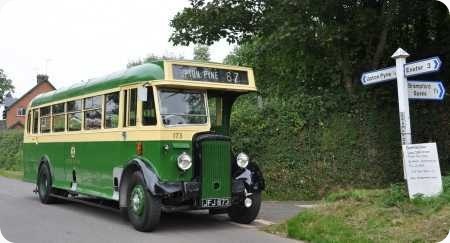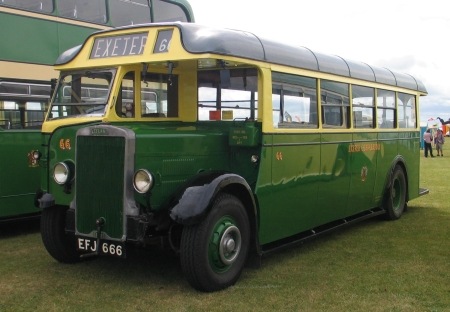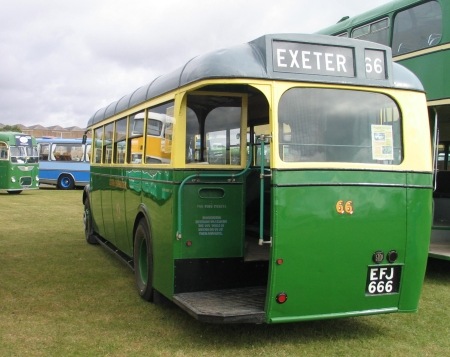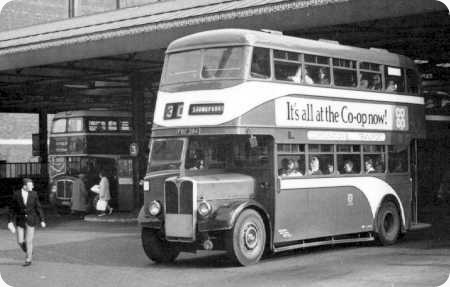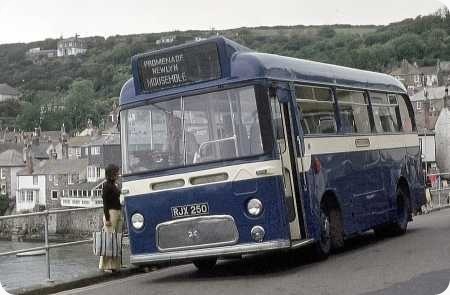Exeter Corporation – Daimler CVD6 – JFJ 873 – 173

Copyright both shots Ken Jones
Exeter Corporation
1950
Daimler CVD6
Weymann B35F
This Exeter City Daimler half cab is more than 60 years old, so even older than me, and is owned by John Handford and based near Solihull in the West Midlands. I’m fortunate to be able to navigate for John on this bus and he has taken it to the Kingsbridge 7ft 6in running day, events in Exeter and the trans Pennine run to name but a few. It has a genuine Exeter City destination blind and letters so in 2009 we took the bus to Exeter and met up with a former Exeter City conductor who worked on such buses and knew all the routes and stops.
Here are two of the pictures I took during the tour around the villages near Exeter. The first on the way back from Upton Pyne at the junction drivers would stop at if passengers wanted to get on or off. The second is crossing the narrow bridge near the village of Bramford Speke.
Visibility for navigating is not ideal, and communicating with John over the engine noise, it has an original Daimler engine, can be limited to reaching out to touch his left or right shoulder. A sister vehicle is preserved at Winkleigh and they were together for the Exeter Nocturnal event in 2011.
It’s a long trip from the West Midlands to Devon – some 6 hours – an endurance test for John as the driver but also for me as the passenger.
Nice vehicle though and full of character, you can sense all the ladies of the villages talking to each other about the latest news whilst they were travelling to and from the City with their groceries.
Photograph and Copy contributed by Ken Jones
06/05/12 – 16:59
Thank you Ken… this has to be one of the best bus photographs that I’ve seen, and it evokes happy memories of times long past, not only working as a rural bus driver, but of a time when the pace of ordinary life was more moderate…
Norman Long
07/05/12 – 09:23
I agree completely Norman – at Samuel Ledgard’s we had four Exeter Corporation Daimler CVD6/Brush double deckers which had their own very special "atmosphere."
JFJ 50/51/52/55 were superbly appointed dignified vehicles full of real "quality" and even sported fascinating offside rear corner chrome bumpers which gave a lovely "pre 1948" touch. Ledgard policy was to equip all second hand purchases with powerful "KL" box type heaters – two under the lower saloon seats and one under the front nearside seat upstairs. As is well known, the large Daimler engines tended to run very hot, and I can honestly say that even in the cruellest of Winter days I’ve known passengers to plead for the heaters to be turned down or off, so effective were they. What happy days those were – and I’m saying this without a pair of rose tinted glasses anywhere to be seen.
Chris Youhill
07/05/12 – 19:16
Next Saturday [14th May] there is an event in Coventry celebrating 100 years of CCT. Some 30 vintage buses will be at former Sandy Lane depot, where the reserve transport museum collection will be open. Some of these buses including JFJ 873 will be operating a shuttle service to the Transport Museum. There will also be a cavalcade of the buses including JFJ 873 at around 16.00
Ken
08/05/12 – 07:20
So, there’s an opportunity for someone in the Coventry area to bag a recording of a CVD6 for the Old Bus Sounds page – any takers?
Stephen Ford
08/05/12 – 07:26
Ken…I think you may have intended to say next Saturday May 12th. Just in case anybody gets mixed up and misses your day!
Richard Leaman
08/05/12 – 10:47
Ken Jones might be interested in the attached pictures of Exeter’s EFJ 666, Leyland Tiger TS8 Cravens B32R. I took the photos at the Gloucester Steam Fair, South Cerney in 2011. This was new in 1938, no less, and was the oldest bus present on the day. It looked and sounded wonderful despite its years
Les Dickinson
08/05/12 – 12:10
Exeter 66 had a role in the film ‘Remains of the Day’ with some very evocative night shots as Emma Thompson boards the bus.
Chris Hough
09/05/12 – 08:04
Yes I meant Saturday May 12th – thanks for pointing out the error
Ken
09/05/12 – 08:05
Did the rear offside seats on any of these single-deckers extend to the very back of the bus, possible because the platform would be split into two steps. The earliest of LGOC/London Transport’s T’s did, until most, but not all, were modified to front entrance. One, T31, is preserved in original condition and, as a rear passenger, I would have felt very insecure, I feel, when going around a right-hand bend!
Chris Hebbron
05/09/12 – 08:42
Thanks for the wonderful old photo’s. I drove these buses also the Guys & the Leyland PD2’s from 1963 to when Exeter City Corporation merged with Devon General, best years of my life. Great to see these old friends being preserved so well. My uniform was donated to the Winkiegh Museum.
Tony Comley
11/09/12 – 05:30
By the time that the last edition of the West of England BBF came out around 1966, the existence of half-a-dozen half-cabs as the only single-deckers in the fleet of Exeter City Transport was already of sufficient curiosity to be remarked upon.
For several years during the ‘nineties, sister vehicle JFJ 875 (Exeter 175) was in the care of Carmel Coaches for operation on Dartmoor Rover summer Sunday service 174 between Okehampton and Moretonhampstead, seen at the latter on a rather damp 3rd August 1997. Unfortunately 175’s body wasn’t entirely Dartmoor-weatherproof by this time and a game of musical busseats usually took place when the rain started.
Michael Wadman
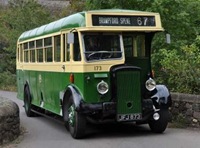 Vehicle reminder shot for this posting
Vehicle reminder shot for this posting
21/10/17 – 10:40
In reply to some 5 year old messages! When the Dartmoor Sunday service 174 started, for the first few years the vehicle and the crew were provided by WETC (i.e. Colin Shears). I travelled one Sunday when the bus was driven by Paul Tucker and the conductor was Colin’s son Dan. Something which just showed how things which one generation takes for granted is completely foreign to the next; Dan was born around 1974 and it was apparent that, growing up in Bideford, he had never set eyes on a bus conductor. When the bus came to a stop, Dan would stand at the top of the steps and collect the fares as the passengers boarded – just like an omo bus driver which is what he would have been familiar with. Anyone who went on the bus for a nostalgic trip where the conductor came round and collected the fares after you had sat down must have been a bit disappointed.
In reply to Chris Hebron’s question, the Exeter Leyland s/d’s of the 1930’s had open platforms at the rear. The whole layout is basically exactly as a normal double decker except that the offside of the platform on 66 and its sisters where the stairs would usually be, was occupied by some shelves for parcels. So far as I know, the JFJ Daimler s/ds were always front entrance.
Peter Cook
23/10/17 – 06:07
Thx, Peter.
Chris Hebbron
Quick links to the - Comments Page - Contact Page - Home Page
